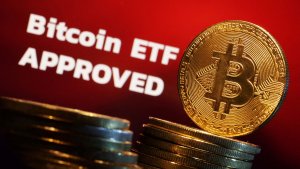What Is Bitcoin's 'Halving', And Does It Matter?
The halving is a change in bitcoin's underlying blockchain technology.

As bitcoin's price reaches new heights, attention is turning to its upcoming "halving" and whether it is playing a role in its ascent.
Depending on where you sit, the halving is a vital event that will burnish bitcoin's value as an increasingly scarce commodity, or nothing more than a technical change talked up by speculators to inflate its price.
But what exactly is it, and does it really matter?
WHAT IS IT?
The halving is a change in bitcoin's underlying blockchain technology, designed to reduce the rate at which new bitcoins are created.
Bitcoin was designed from its inception by its pseudonymous creator Satoshi Nakamoto to have a capped supply of 21 million tokens.
Nakamoto wrote the halving into bitcoin's code and it works by reducing the rate at which new bitcoin are released into circulation.
So far, about 19 million tokens have been released.
HOW DOES IT HAPPEN?
Blockchain technology involves creating records of information - called 'blocks' - which are added to the chain in a process called 'mining'.
Miners use computing power to solve complex mathematical puzzles to build the blockchain and earn rewards in the form of new bitcoin.
At the halving, the amount of bitcoin available as rewards for miners is cut in half. This makes mining less profitable and slows the production of new bitcoins.
(For a visual explanation of how blockchain works, click here.)
WHEN WILL IT HAPPEN?
There is no set date, but it is expected to take place in late April.
The blockchain is designed so that a halving occurs every time 210,000 blocks are added to the chain. This means it happens roughly every four years.
WHAT'S IT GOT TO DO WITH BITCOIN'S PRICE?
Some bitcoin enthusiasts say that bitcoin's scarcity gives it value.
The lower the supply of a commodity, then all other things being equal the price should rise when people try and buy more.
So reducing supply of bitcoin should lift the price, some analysts and traders say.
Others dispute the logic, noting that any impact would have already been factored in to the current price.
The supply of bitcoin to the market is also largely down to crypto miners but the sector is opaque, with data on inventories and supplies scarce.
If miners sell their reserves, that could put downward pressure on prices.
Knowing what is behind a crypto rally is hard, not least as there is far less transparency about who is buying and why relative to other markets.
The most common reason given for this year's surge is the U.S. Securities and Exchange Commission's January approval of bitcoin ETFs, as well as expectations that central banks will cut interest rates.
But in the speculative world of crypto trading, explanations given by analysts for changes in bitcoin's price can snowball into market narratives that can become self-fulfilling.
WHAT ABOUT PREVIOUS HALVINGS?
There's no evidence to suggest that previous halvings have caused bitcoin's price to rise.
Still, traders and miners have studied past halvings to try and gain an edge.
When the last halving happened on May 11, 2020, the price rose around 12% in the following week.
Later in the year, bitcoin began a sharp rally, but there were lots of explanations - including loose monetary policy and stay-at-home retail investors spending spare cash on cryptocurrencies - for this and no real evidence the halving was behind it.
An earlier halving occurred in July 2016. Bitcoin rose around 1.3% in the following week, before plunging a few weeks later.
In short: it's hard to isolate the impact, if any, halvings may have had in the past or predict what could happen this time around.
Regulators have repeatedly warned that bitcoin is a speculative market, driven by hype and "FOMO" (Fear Of Missing Out), and poses real harm to investors, even as they simultaneously approve bitcoin trading products.
(Reporting by Elizabeth Howcroft and Tommy Reggiori Wilkes, Editing by Louise Heavens)
Thanks for signing up to Minutehack alerts.
Brilliant editorials heading your way soon.
Okay, Thanks!

